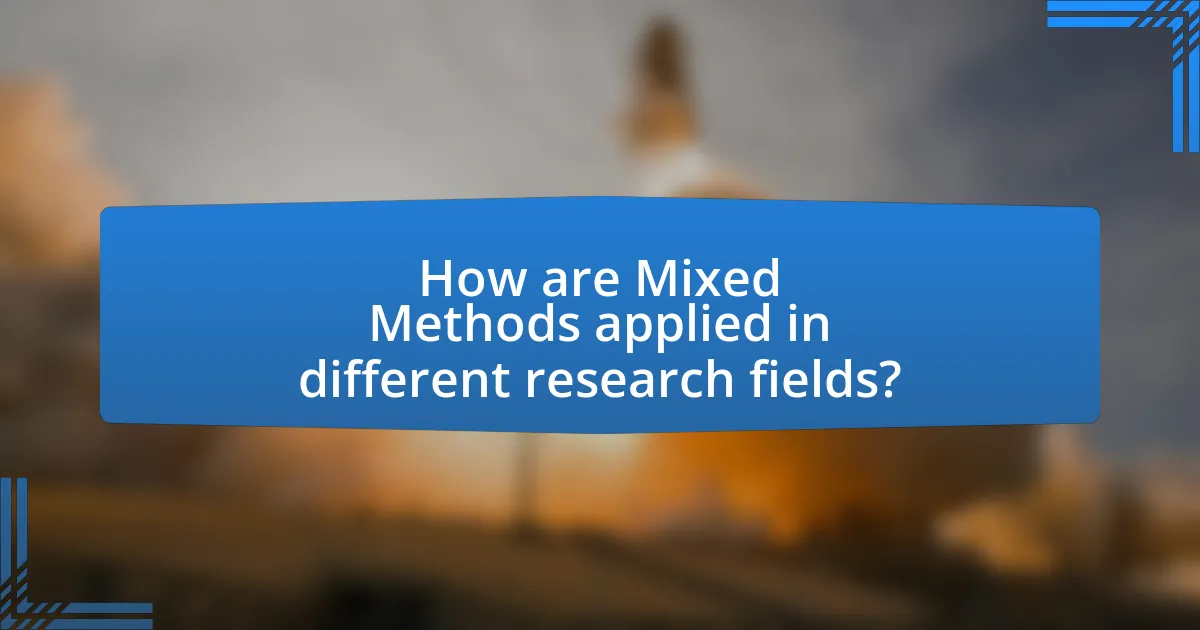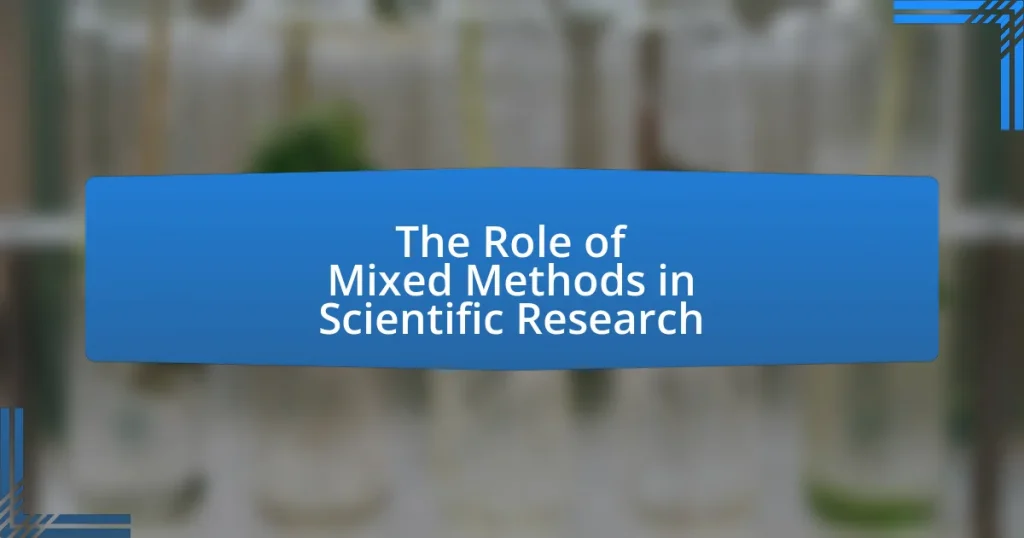Mixed methods in scientific research refer to an approach that integrates qualitative and quantitative research techniques to enhance understanding of complex research problems. This methodology allows for the collection and analysis of both numerical and narrative data, leading to richer interpretations and more robust conclusions. The article outlines the differences between mixed methods and traditional research methods, key characteristics, advantages, and the importance of combining qualitative and quantitative approaches. It also discusses the application of mixed methods across various fields, challenges faced by researchers, and best practices for effective implementation, supported by relevant case studies and literature.

What are Mixed Methods in Scientific Research?
Mixed methods in scientific research refer to an approach that combines qualitative and quantitative research techniques to provide a more comprehensive understanding of a research problem. This methodology allows researchers to collect and analyze both numerical data and narrative data, enhancing the depth and breadth of the findings. For instance, a study might use surveys to gather quantitative data while also conducting interviews to gain qualitative insights, thereby triangulating results for greater validity. The integration of these methods can lead to richer data interpretation and more robust conclusions, as evidenced by studies such as the one conducted by Creswell and Plano Clark, which emphasizes the value of mixed methods in addressing complex research questions.
How do Mixed Methods differ from Traditional Research Methods?
Mixed methods differ from traditional research methods by integrating both qualitative and quantitative approaches to data collection and analysis. Traditional research methods typically focus on either qualitative or quantitative data, leading to a more limited understanding of research questions. In contrast, mixed methods allow researchers to triangulate data, enhancing the validity and depth of findings by combining numerical data with contextual insights. This approach has been validated in studies such as the one by Creswell and Plano Clark, which emphasizes that mixed methods can provide a more comprehensive perspective on complex research problems.
What are the key characteristics of Mixed Methods?
Mixed methods research is characterized by the integration of both qualitative and quantitative approaches within a single study. This approach allows for a comprehensive analysis of research questions by leveraging the strengths of both methodologies. Specifically, mixed methods research facilitates triangulation, where findings from one method can validate or enhance findings from another, thereby increasing the overall validity of the results. Additionally, it promotes a more nuanced understanding of complex phenomena by capturing diverse perspectives and data types. The combination of qualitative insights and quantitative data enables researchers to address research questions more holistically, making mixed methods particularly valuable in fields such as social sciences and health research.
Why is it important to combine qualitative and quantitative approaches?
Combining qualitative and quantitative approaches is important because it enhances the depth and breadth of research findings. Qualitative methods provide rich, detailed insights into participants’ experiences and motivations, while quantitative methods offer statistical validity and generalizability. For instance, a study published in the Journal of Mixed Methods Research by Creswell and Plano Clark (2011) demonstrates that integrating both approaches allows researchers to triangulate data, leading to more comprehensive conclusions. This mixed-methods strategy not only validates findings through multiple lenses but also addresses complex research questions more effectively.
What are the main components of Mixed Methods?
The main components of Mixed Methods are qualitative and quantitative research approaches. Qualitative research focuses on understanding phenomena through in-depth exploration of participants’ perspectives, while quantitative research emphasizes numerical data and statistical analysis to identify patterns and relationships. The integration of these two approaches allows for a comprehensive understanding of research questions, as evidenced by studies that demonstrate how combining qualitative insights with quantitative data enhances the validity and richness of findings. For instance, a study by Creswell and Plano Clark (2011) highlights that Mixed Methods can provide a more nuanced understanding of complex issues by leveraging the strengths of both methodologies.
How is qualitative data collected and analyzed in Mixed Methods?
Qualitative data in Mixed Methods is collected through various techniques such as interviews, focus groups, and observations. These methods allow researchers to gather in-depth insights and understand participants’ perspectives. The analysis of qualitative data typically involves coding the data into themes or categories, which helps in identifying patterns and drawing conclusions. For instance, thematic analysis is a common approach where researchers systematically identify and analyze themes within the data, ensuring a comprehensive understanding of the qualitative aspects. This combination of collection and analysis techniques enhances the richness of the research findings, providing a more nuanced understanding of the research problem.
What role does quantitative data play in Mixed Methods research?
Quantitative data plays a critical role in Mixed Methods research by providing measurable and statistically analyzable information that complements qualitative insights. This integration allows researchers to triangulate data, enhancing the validity and reliability of findings. For instance, a study may use quantitative surveys to gather numerical data on participant demographics while employing qualitative interviews to explore personal experiences, thus creating a comprehensive understanding of the research problem. The combination of these data types enables a more nuanced interpretation of results, as evidenced by research conducted by Creswell and Plano Clark, which emphasizes the importance of integrating quantitative and qualitative approaches to enrich the overall research outcomes.
What are the advantages of using Mixed Methods in Scientific Research?
The advantages of using Mixed Methods in Scientific Research include the ability to triangulate data, enhance the validity of findings, and provide a more comprehensive understanding of research questions. Triangulation occurs when qualitative and quantitative data are combined, allowing researchers to cross-verify results and reduce biases inherent in single-method studies. This approach enhances validity by integrating diverse perspectives, which can lead to richer insights and more robust conclusions. For instance, a study published in the Journal of Mixed Methods Research by Creswell and Plano Clark (2011) highlights that Mixed Methods can address complex research problems more effectively than either qualitative or quantitative methods alone, thereby improving the overall quality of research outcomes.
How do Mixed Methods enhance the validity of research findings?
Mixed methods enhance the validity of research findings by integrating qualitative and quantitative data, which allows for a more comprehensive understanding of research questions. This approach mitigates the limitations inherent in using a single method, as qualitative data can provide context and depth to quantitative results, while quantitative data can offer generalizability and statistical rigor to qualitative insights. For instance, a study by Creswell and Plano Clark (2011) highlights that combining these methods can lead to triangulation, where corroborating evidence from different sources strengthens the overall findings. This triangulation process increases the credibility and reliability of the research outcomes, ultimately leading to more robust conclusions.
What insights can Mixed Methods provide that single-method approaches cannot?
Mixed methods provide insights that single-method approaches cannot by integrating qualitative and quantitative data, allowing for a more comprehensive understanding of research questions. This integration enables researchers to validate findings through triangulation, where qualitative insights can explain the “why” behind quantitative results, enhancing the depth of analysis. For instance, a study on patient satisfaction may use surveys (quantitative) alongside interviews (qualitative) to uncover underlying reasons for satisfaction levels, revealing nuances that numbers alone cannot convey. This methodological synergy leads to richer, more actionable insights, ultimately improving the robustness of research outcomes.

How are Mixed Methods applied in different research fields?
Mixed methods are applied in various research fields by integrating qualitative and quantitative approaches to enhance understanding of complex phenomena. In education research, for instance, mixed methods allow for the collection of numerical data through standardized tests alongside qualitative insights from interviews, providing a comprehensive view of student learning outcomes. In healthcare, researchers utilize mixed methods to combine clinical trial data with patient experiences, enabling a more holistic assessment of treatment effectiveness. Social sciences often employ mixed methods to explore societal issues, where quantitative surveys can quantify trends while qualitative interviews reveal underlying motivations. This approach is validated by studies such as the one conducted by Creswell and Plano Clark, which emphasizes the value of mixed methods in addressing multifaceted research questions across disciplines.
What are some examples of Mixed Methods in social sciences?
Examples of mixed methods in social sciences include studies that combine qualitative interviews with quantitative surveys to explore complex social phenomena. For instance, a research project might utilize surveys to gather numerical data on public opinion regarding a policy, while also conducting in-depth interviews to understand the underlying reasons for those opinions. Another example is a study that employs focus groups to generate qualitative insights, followed by statistical analysis of the data collected from a larger sample to validate those insights. These approaches allow researchers to triangulate data, enhancing the validity and richness of their findings.
How do researchers implement Mixed Methods in psychology studies?
Researchers implement Mixed Methods in psychology studies by integrating both qualitative and quantitative research approaches to gain a comprehensive understanding of psychological phenomena. This integration often involves collecting quantitative data through surveys or experiments, while simultaneously gathering qualitative data through interviews or focus groups. For instance, a study may use statistical analysis to identify trends in behavior and then employ thematic analysis on interview transcripts to explore participants’ experiences and motivations behind those behaviors. This dual approach allows researchers to triangulate data, enhancing the validity and richness of their findings, as evidenced by studies like Creswell and Plano Clark’s “Designing and Conducting Mixed Methods Research,” which highlights the effectiveness of Mixed Methods in addressing complex research questions in psychology.
What case studies illustrate the effectiveness of Mixed Methods in sociology?
Case studies that illustrate the effectiveness of Mixed Methods in sociology include the research conducted by Tashakkori and Teddlie (2003) in their work “Handbook of Mixed Methods in Social & Behavioral Research.” This study demonstrated how combining qualitative and quantitative approaches can provide a more comprehensive understanding of social phenomena. Another notable case is the study by Creswell and Plano Clark (2011) in “Designing and Conducting Mixed Methods Research,” which highlighted the benefits of Mixed Methods in exploring complex social issues, such as health disparities, by integrating statistical data with personal narratives. These examples underscore the ability of Mixed Methods to enhance the depth and breadth of sociological research, allowing for richer insights and more robust conclusions.
What challenges do researchers face when using Mixed Methods?
Researchers face several challenges when using Mixed Methods, primarily related to the integration of qualitative and quantitative data. One significant challenge is the complexity of designing a study that effectively combines both methodologies, which requires a deep understanding of each approach’s strengths and limitations. Additionally, researchers often struggle with data interpretation, as merging qualitative insights with quantitative results can lead to conflicting conclusions. A study by Creswell and Plano Clark (2011) highlights that researchers frequently encounter difficulties in justifying the use of Mixed Methods, particularly in terms of methodological rigor and the clarity of research questions. Furthermore, logistical issues such as time constraints and resource allocation can hinder the execution of Mixed Methods research, making it a demanding endeavor.
How can researchers overcome methodological challenges in Mixed Methods?
Researchers can overcome methodological challenges in Mixed Methods by employing a clear integration strategy that aligns qualitative and quantitative components. This approach ensures that the research questions guide the selection of methods, allowing for a coherent framework that addresses the complexities of the study. For instance, using a sequential explanatory design can help clarify findings by first collecting quantitative data and then exploring those results through qualitative interviews. This method has been validated in studies such as the one by Creswell and Plano Clark, which emphasizes the importance of methodological rigor and the need for triangulation to enhance validity. By systematically addressing the integration of data types, researchers can effectively navigate the inherent challenges of Mixed Methods research.
What ethical considerations must be addressed in Mixed Methods research?
Ethical considerations in Mixed Methods research include informed consent, confidentiality, and the potential for bias. Informed consent requires researchers to ensure that participants understand the nature of the study and agree to participate voluntarily. Confidentiality involves protecting participants’ identities and data, which is crucial when integrating qualitative and quantitative data. Additionally, researchers must be aware of potential biases that may arise from the different methodologies used, as these can affect the validity of the findings. Addressing these ethical considerations is essential to uphold the integrity of the research and protect participants’ rights.

What best practices should researchers follow when employing Mixed Methods?
Researchers should follow several best practices when employing Mixed Methods, including clearly defining research questions, integrating qualitative and quantitative data effectively, and ensuring methodological rigor. Clearly defined research questions guide the study design and help in selecting appropriate methods for data collection and analysis. Effective integration of qualitative and quantitative data enhances the comprehensiveness of findings, allowing for a more nuanced understanding of the research problem. Ensuring methodological rigor involves adhering to established standards for both qualitative and quantitative research, which strengthens the validity and reliability of the results. These practices are supported by the work of Creswell and Plano Clark, who emphasize the importance of these elements in their book “Designing and Conducting Mixed Methods Research.”
How can researchers effectively design a Mixed Methods study?
Researchers can effectively design a Mixed Methods study by integrating both qualitative and quantitative approaches to address research questions comprehensively. This involves clearly defining the research objectives, selecting appropriate methods for data collection, and ensuring that the qualitative and quantitative components are aligned to provide a cohesive understanding of the research problem. For instance, a study might begin with qualitative interviews to explore participants’ experiences, followed by a quantitative survey to measure the prevalence of those experiences across a larger population. This sequential approach allows for triangulation, enhancing the validity of the findings by corroborating evidence from different sources. Additionally, researchers should consider the timing of data collection, whether concurrent or sequential, and ensure that the analysis methods for both types of data are compatible, thereby facilitating a richer interpretation of the results.
What strategies can enhance the integration of qualitative and quantitative data?
Utilizing triangulation, data transformation, and iterative analysis are effective strategies to enhance the integration of qualitative and quantitative data. Triangulation involves using multiple data sources or methods to cross-verify findings, which strengthens the validity of the results. For instance, combining survey data (quantitative) with interviews (qualitative) can provide a more comprehensive understanding of a research question. Data transformation refers to converting qualitative data into quantitative formats, such as coding interview responses into numerical values, allowing for statistical analysis alongside qualitative insights. Iterative analysis involves continuously refining research questions and methods based on initial findings, fostering a dynamic integration process. These strategies collectively improve the robustness and depth of mixed methods research, as evidenced by studies that demonstrate enhanced insights when both data types are effectively combined.
How should researchers report Mixed Methods findings to ensure clarity?
Researchers should report Mixed Methods findings by clearly integrating qualitative and quantitative data to provide a comprehensive understanding of the research question. This involves presenting the results in a way that highlights how the qualitative insights complement the quantitative findings, ensuring that both types of data are given appropriate context and significance. For instance, researchers can use visual aids such as tables and figures to juxtapose qualitative themes with quantitative results, thereby enhancing clarity. Additionally, they should explicitly discuss the implications of the combined findings, illustrating how they contribute to the overall conclusions of the study. This approach is supported by the guidelines from the American Psychological Association, which emphasize the importance of clarity and coherence in reporting mixed methods research.
What resources are available for researchers interested in Mixed Methods?
Researchers interested in Mixed Methods can access a variety of resources, including academic journals, textbooks, and online courses. Notable journals such as the “Journal of Mixed Methods Research” provide peer-reviewed articles that explore methodologies and case studies. Textbooks like “Mixed Methods Research: A Guide to the Field” by Vicki L. Plano Clark and Nancy E. P. Creswell offer comprehensive insights into the design and implementation of mixed methods. Additionally, platforms like Coursera and edX offer online courses that cover mixed methods research, enhancing practical skills and theoretical knowledge. These resources collectively support researchers in understanding and applying mixed methods effectively in their studies.
What books and articles provide guidance on Mixed Methods research?
Books and articles that provide guidance on Mixed Methods research include “Mixed Methods Research: A Guide to the Field” by Vicki L. Plano Clark and Jennifer W. Creswell, which offers a comprehensive overview of the methodology. Additionally, “Designing and Conducting Mixed Methods Research” by Creswell and Plano Clark serves as a practical resource for researchers. The article “The Mixed Methods Research: A New Paradigm for Social Science Research” by Tashakkori and Teddlie discusses the theoretical foundations and applications of Mixed Methods. These sources are widely recognized in the academic community for their contributions to understanding and implementing Mixed Methods research effectively.
How can online courses and workshops improve skills in Mixed Methods?
Online courses and workshops can significantly enhance skills in Mixed Methods by providing structured learning environments that combine theoretical knowledge with practical application. These educational formats often include interactive components, such as case studies and real-world projects, which allow participants to apply Mixed Methods techniques in various research scenarios. Research indicates that hands-on experience, facilitated through guided instruction, leads to improved competency in integrating qualitative and quantitative approaches, as highlighted in studies like “The Effectiveness of Online Learning in Higher Education: A Review of the Literature” by Bernard et al. (2004), which shows that online learning can be as effective as traditional methods when designed properly. Additionally, access to expert instructors and peer collaboration in online settings fosters a deeper understanding of Mixed Methods, enabling learners to refine their skills and adapt them to diverse research contexts.
What are the future trends in Mixed Methods research?
Future trends in Mixed Methods research include increased integration of qualitative and quantitative data, enhanced use of technology for data collection and analysis, and a greater emphasis on interdisciplinary approaches. Researchers are increasingly recognizing the value of combining diverse methodologies to provide a more comprehensive understanding of complex phenomena. For instance, advancements in software tools facilitate the simultaneous analysis of qualitative and quantitative data, allowing for richer insights. Additionally, interdisciplinary collaboration is becoming more common, as it enables researchers to draw on various fields to address multifaceted research questions. These trends are supported by a growing body of literature emphasizing the effectiveness of Mixed Methods in producing robust and nuanced findings.
How is technology influencing the evolution of Mixed Methods?
Technology is significantly influencing the evolution of Mixed Methods by enhancing data collection, analysis, and integration processes. Advanced software tools and platforms enable researchers to efficiently gather qualitative and quantitative data, facilitating a more comprehensive understanding of complex research questions. For instance, the use of online survey tools and data analytics software allows for real-time data collection and analysis, which streamlines the integration of diverse data types. Additionally, technologies such as machine learning and natural language processing are increasingly being employed to analyze qualitative data, providing deeper insights and improving the rigor of Mixed Methods research. This technological advancement not only increases the efficiency of research but also enhances the validity and reliability of findings, as evidenced by studies demonstrating improved outcomes in research projects that utilize these technologies.
What emerging fields are likely to adopt Mixed Methods approaches?
Emerging fields likely to adopt Mixed Methods approaches include health informatics, environmental science, and education technology. Health informatics combines quantitative data from health records with qualitative insights from patient experiences to improve healthcare delivery. Environmental science utilizes Mixed Methods to integrate statistical data on climate change with community narratives, enhancing understanding of local impacts. Education technology employs Mixed Methods to evaluate the effectiveness of digital learning tools by analyzing both test scores and student feedback, leading to more comprehensive educational strategies. These fields demonstrate the growing recognition of Mixed Methods as a valuable approach for addressing complex research questions.


